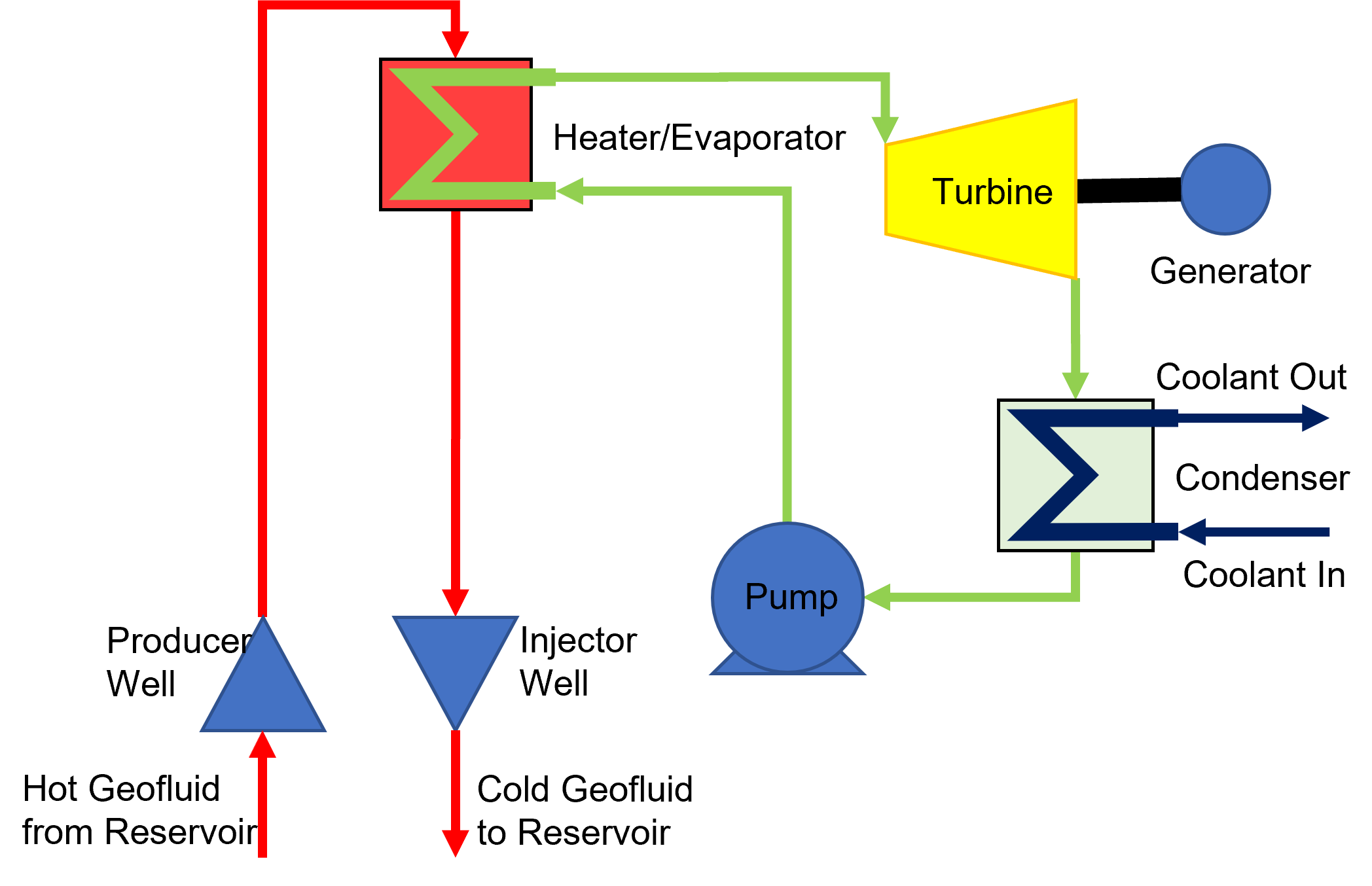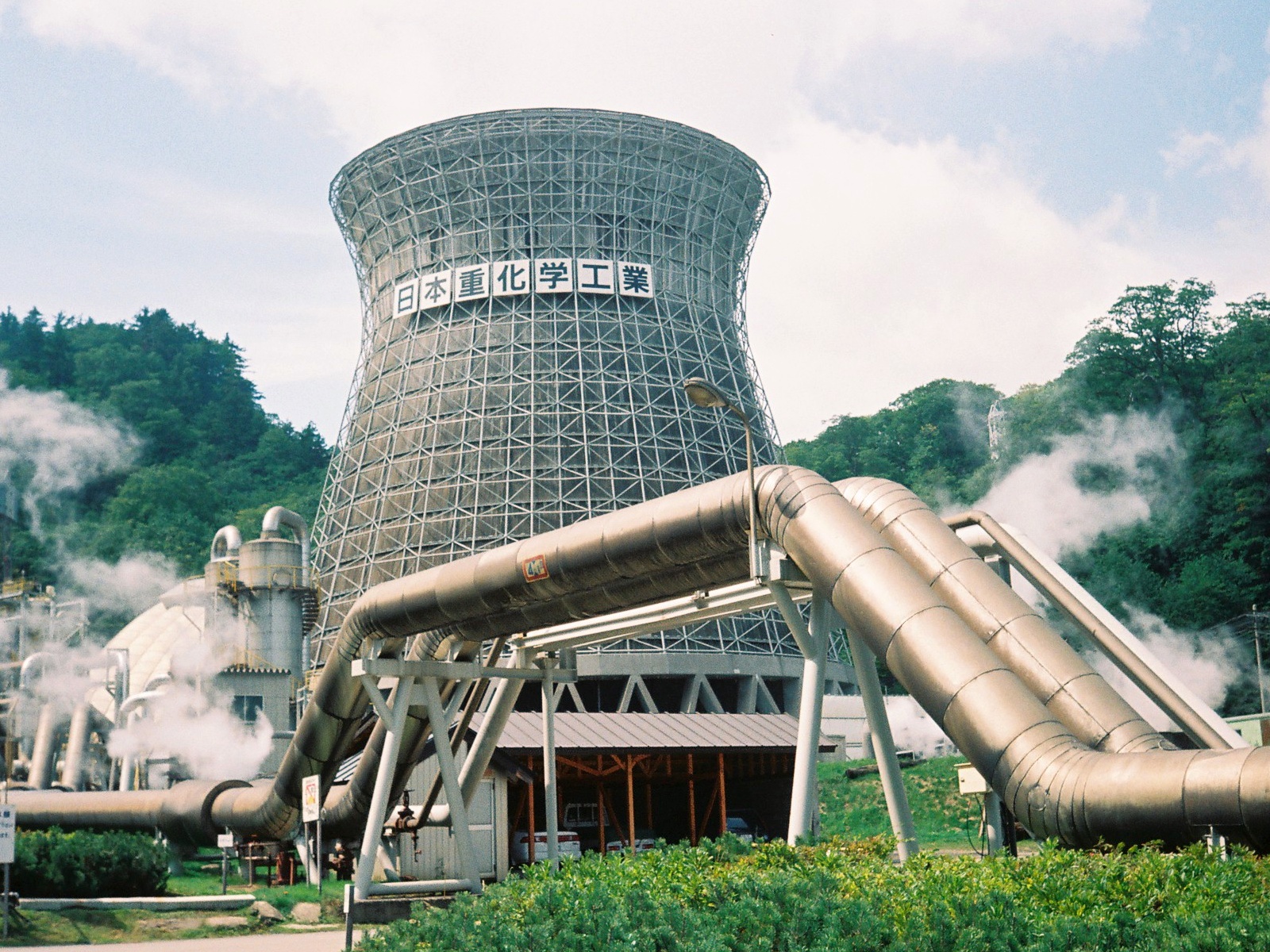|
Hatchōbaru Geothermal Power Plant
The is a large geothermal power station in Ōita Prefecture, Japan. At 112 MW, it is the largest geothermal power plant in the country. The plant comprises 3 generation units. The first unit, with a capacity of 55 MW, was activated in June 1977. A second unit started operation in June 1990, with an additional 55 MW capacity. A third binary unit rated at 2 MW is operational since April 2006. The first unit was among the first double flash geothermal generation units. The second unit is very similar to the first, with some technical improvements based on the experience gained from the operation of unit 1. The power station is located in Kokonoe town, in the Aso Kujū National Park. Another geothermal power station, the Otake plant with a capacity of 12.5 MW, is located about 2 km from Hatchobaru plant. The location in a national park, and the presence of popular tourist attractions nearby, means that the plant is subject to strict limits and controls over location of wells, d ... [...More Info...] [...Related Items...] OR: [Wikipedia] [Google] [Baidu] |
Ōita Prefecture
is a prefecture of Japan located on the island of Kyūshū. Ōita Prefecture has a population of 1,136,245 (1 June 2019) and has a geographic area of 6,340 km2 (2,448 sq mi). Ōita Prefecture borders Fukuoka Prefecture to the northwest, Kumamoto Prefecture to the southwest, and Miyazaki Prefecture to the south. Ōita is capital and largest city of Ōita Prefecture, with other major cities including Beppu, Nakatsu, and Saiki. Ōita Prefecture is located in the northeast of Kyūshū on the Bungo Channel, connecting the Pacific Ocean and Seto Inland Sea, across from Ehime Prefecture on the island of Shikoku. Ōita Prefecture is famous for its hot springs and is a popular tourist destination in Japan for its '' onsens'' and '' ryokans'', particularly in and around the city of Beppu. History Around the 6th century Kyushu consisted of four regions: Tsukushi Province, Hi Province, Kumaso Province and Toyo Province. Toyo Province was later divided into two regions, upper and ... [...More Info...] [...Related Items...] OR: [Wikipedia] [Google] [Baidu] |
Kyushu Electric Power Company
(, OSE: 9508, ) is a Japanese energy company that provides power to 7 prefectures ( Fukuoka, Nagasaki, Ōita, Saga, Miyazaki, Kumamoto, Kagoshima), and recently, to some parts of Hiroshima Prefecture. Its shortened name of is sometimes used. In 2011 the company was criticised for attempting to manipulate public opinion in favor of reactivating two reactors at the Genkai Nuclear Power Plant. History Kyushu Electric Power was founded on 1 May 1951. The company began supplying electricity to Hiroshima in November 2005 - the first provider in Japan to supply energy outside its area. See also * Fukushima Daiichi nuclear disaster The was a nuclear accident in 2011 at the Fukushima Daiichi Nuclear Power Plant in Ōkuma, Fukushima, Japan. The proximate cause of the disaster was the 2011 Tōhoku earthquake and tsunami, which occurred on the afternoon of 11 March 2011 and ... * Kagoshima Nanatsujima Mega Solar Power Plant * Nuclear power in Japan References ... [...More Info...] [...Related Items...] OR: [Wikipedia] [Google] [Baidu] |
Binary Cycle
A binary cycle is a method for generating electrical power from geothermal resources and employs two separate fluid cycles, hence binary cycle. The primary cycle extracts the geothermal energy from the reservoir, and secondary cycle converts the heat into work to drive the generator and generate electricity. Binary cycles permit electricity generation even from low temperature geothermal resources (<180°C) that would otherwise produce insufficient quantities of steam to make flash power plants economically viable. However, due to the lower temperatures binary cycles have low overall efficiencies of about 10-13%. Introduction [...More Info...] [...Related Items...] OR: [Wikipedia] [Google] [Baidu] |
Geothermal Power Station
Geothermal power is electrical power generated from geothermal energy. Technologies in use include dry steam power stations, flash steam power stations and binary cycle power stations. Geothermal electricity generation is currently used in 26 countries,Geothermal Energy AssociationGeothermal Energy: International Market Update May 2010, p. 4-6. while geothermal heating is in use in 70 countries. As of 2019, worldwide geothermal power capacity amounts to 15.4 gigawatts (GW), of which 23.9 percent or 3.68 GW are installed in the United States. International markets grew at an average annual rate of 5 percent over the three years to 2015, and global geothermal power capacity is expected to reach 14.5–17.6 GW by 2020. Based on current geologic knowledge and technology the Geothermal Energy Association (GEA) publicly discloses, the GEA estimates that only 6.9 percent of total global potential has been tapped so far, while the IPCC reported geothermal power potential to be ... [...More Info...] [...Related Items...] OR: [Wikipedia] [Google] [Baidu] |
Binary Cycle
A binary cycle is a method for generating electrical power from geothermal resources and employs two separate fluid cycles, hence binary cycle. The primary cycle extracts the geothermal energy from the reservoir, and secondary cycle converts the heat into work to drive the generator and generate electricity. Binary cycles permit electricity generation even from low temperature geothermal resources (<180°C) that would otherwise produce insufficient quantities of steam to make flash power plants economically viable. However, due to the lower temperatures binary cycles have low overall efficiencies of about 10-13%. Introduction [...More Info...] [...Related Items...] OR: [Wikipedia] [Google] [Baidu] |
Aso Kujū National Park
is a national park in Kumamoto and Ōita Prefectures, Japan. The park derives its name from Mount Aso, the largest active volcano in Japan, and the Kujū mountains. History Established as Aso National Park in 1934, in 1986 after extension the park was renamed Aso Kujū National Park. Related municipalities * Kumamoto: Aso, Kikuchi, Minamiaso, Minamioguni, Oguni, Ōzu, Takamori, Ubuyama * Ōita: Beppu, Kokonoe, Kusu, Taketa, Yufu See also *List of national parks of Japan and in Japan are places of scenic beauty designated for protection and sustainable usage by the Minister of the Environment under the of 1957. National Parks are designated and in principle managed by the Ministry of the Environment. Quasi-Nat ... References External links *Aso Kujū National Park*Aso Kujū National ParkMap of Aso Kujū National Park (North)Map of Aso Kujū National Park (South) National parks of Japan Parks and gardens in Kumamoto Prefecture Parks and gardens in ... [...More Info...] [...Related Items...] OR: [Wikipedia] [Google] [Baidu] |
Butterworth-Heinemann
Butterworth–Heinemann is a British publishing company specialised in professional information and learning materials for higher education and professional training, in printed and electronic forms. It was formed in 1990 by the merger of Heinemann Professional Publishing and Butterworths Scientific, both subsidiaries of Reed International. With its earlier constituent companies, the founding dates back to 1923. It has publishing units in Oxford (UK) and Waltham, Massachusetts (United States). As of 2006, it is an imprint of Elsevier. See also *LexisNexis Butterworths LexisNexis is a part of the RELX corporation that sells data analytics products and various databases that are accessed through online portals, including portals for computer-assisted legal research (CALR), newspaper search, and consumer informa ... References External links * Book publishing companies of the United Kingdom Elsevier imprints {{publish-corp-stub ... [...More Info...] [...Related Items...] OR: [Wikipedia] [Google] [Baidu] |
Mount Kujū
, located on the border of Kokonoe and Taketa in Ōita Prefecture, Japan, is the highest mountain in Kyushu Island, Japan, with a summit elevation of . It is one of the 100 Famous Japanese Mountains. It is part of the Aso-Kujū National Park. Summary The Kujū range consists of a dozen or so volcanic bodies gathered in a region of 13km east-west and 10km north-south. The mountains in the range include: *Kujū Mountains **Mount Kujū (1,787 m)- The main peak (久住山) **Mount Nakadake (1,791 m)- The highest peak in Kyushu **Mount Inahoshi (1,774 m) **Mount Hōsshō (1,762 m) **Mount Mimata (1,745 m) *Taisen Mountains **Mount Taisen (1,786 m) **Mount North (Kita) Taisen (1,706 m) **Mount Heiji (1,642 m) The Kujū volcanic group is mainly composed of andesite and dacite, which is defined as the volcanic activity above the Miyagi pyroclastic flow deposit which formed about 200,000 years ago. The north and south areas of Mt. Kujū are plateau grasslands whose main industry is d ... [...More Info...] [...Related Items...] OR: [Wikipedia] [Google] [Baidu] |
Geothermal Power In Japan
Japan has favorable sites for geothermal power because of its proximity to the Izu–Bonin–Mariana Arc. In 2007, Japan had 535.2 MW of installed electric generating capacity, about 5% of the world total. Geothermal power plays a minor role in the energy sector in the country: in 2013 it supplied 2596 GWh of electricity, representing about 0.25% of the country's total electricity supply. Development of new geothermal power stations essentially stopped since the mid 1990s, mainly due to the strong resistance from local communities. Most of the potential sites are located in government-protected areas and in tourist destinations, thanks to the presence of traditional hot springs or onsen. Local communities in these areas are often dependent on revenue from tourists visiting onsen, and are opposed to geothermal developments because of the negative impact that the industry may have on the scenery and the resulting damage to the tourism industry and the local economy. However, inter ... [...More Info...] [...Related Items...] OR: [Wikipedia] [Google] [Baidu] |





